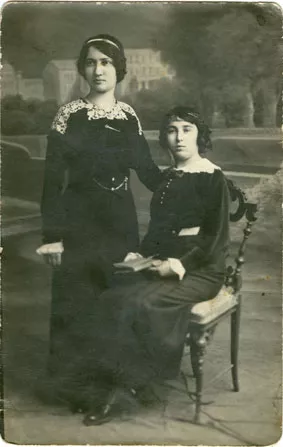Fani and Ana Faierstein
These are the sisters of my wife's father, aunt Fani Faierstein is on the left and aunt Ana is on the right. I think the photograph was taken before they got married, they were very young at the time. The photograph was probably taken in 1915. I couldn't say what the occasion was, but it was certainly in a photo studio somewhere in Iasi. My wife's family was from Iasi, they were all born and raised in Iasi.
My wife's maiden name was Devora Faiestein. She too was born in Iasi, in January 1925. We met for the first time in our Jewish neighborhood, I fell in love with her and to this age, after 56 years of marriage, I'm still in love with her. When I come home and ring the doorbell, and she opens the door for me, it's as if a spotlight lights up the entire house. When I was going to work in the morning and by the time I returned home, I'd start missing her as I didn't see her all day long.
My wife often talks about her parents. Her parents met around 1913, probably in Sculeni [Ed. note: Village in the county of Iasi located on the right riverbank of the river Prut, on the border with the Republic of Moldova, 31 km north-east of Iasi]. Immediately afterwards, the war broke out and her father served on the front for about 6 years. When Bucharest was occupied by the German army, king Ferdinand and the government took refuge in Iasi. My wife's mother was from Sculeni and she went [to Iasi] to visit a neighbor in those days. The neighbor told her: 'Do you want to see the king? Here, pull that small curtain to the side and inside you will see the king.' Her mother was very curious, she pulled the curtain and saw the king. She asked that neighbor if she could ask for something from the king. Her neighbor told her to give it a try, but that she should talk quietly and respectfully. Then she asked the king in a Romanian with a countryside accent because, as she lived in the countryside, she spoke with a peasant's accent, if she could go to the front to see her husband, meaning my wife's father. The king approved of it, and her mother got on the train and left. It seems that they met somewhere on the front, but it was only 6 years later, around 1919-1920, when the peace was signed and her father returned from the front, that they got married.
My wife's family observed the Jewish customs and traditions. They weren't very religious, in the sense that none of them wore sideburns or a straml [Yiddish: a special fur hat worn on the Sabbath and on Jewish holidays, especially by the Hasidim], but they observed all holidays, attended the synagogue on Saturday and on holidays, they observed the kashrut.
































